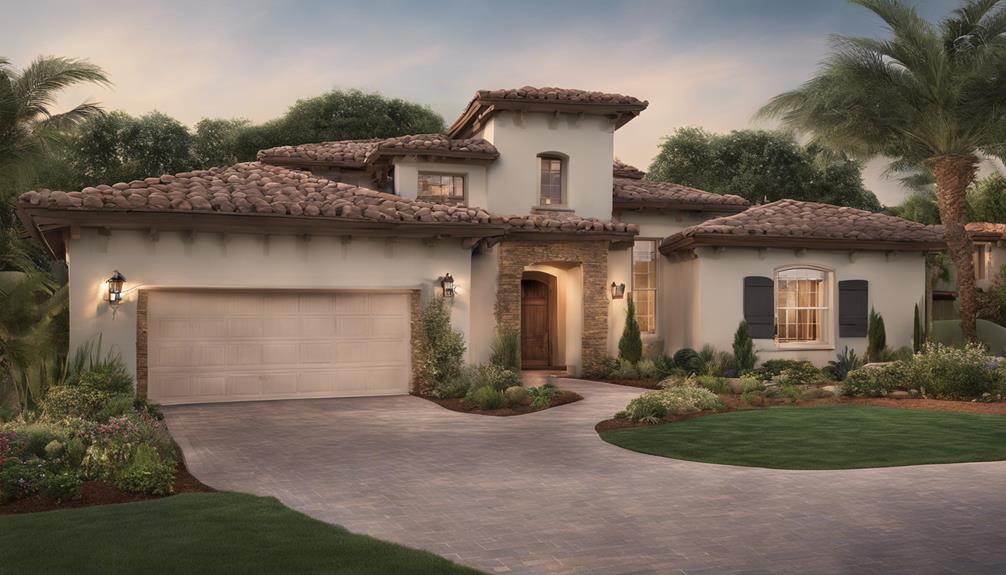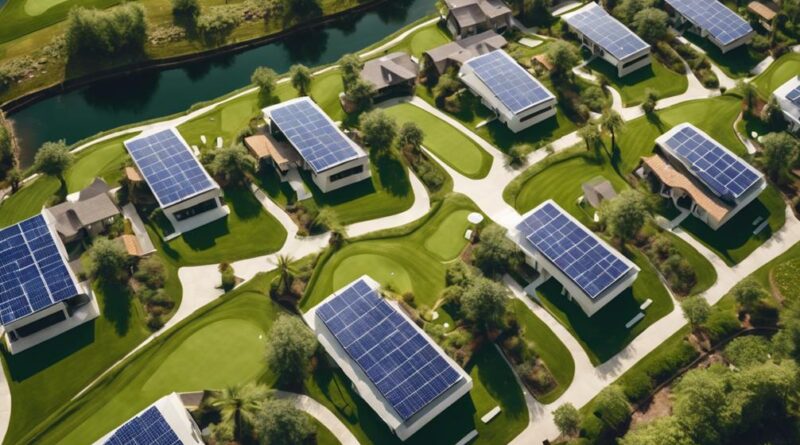7 Tips for Choosing Eco-Friendly Golf Community Homes
When choosing eco-friendly golf community homes, consider these 7 key tips: 1) Prioritize a convenient location with green transportation options. 2) Opt for energy-efficient features like solar panels and smart thermostats. 3) Look for water-saving technologies and sustainable landscaping practices. 4) Choose green building materials such as recycled products and energy-efficient windows. 5) Assess community amenities like golf courses and fitness centers. 6) Check for environmental certifications and sustainable standards. By focusing on these areas, you'll find a home that not only aligns with your values but also offers a luxurious, environmentally responsible lifestyle.
Location Matters
When choosing eco-friendly golf community homes, consider the location carefully to ensure sustainability and environmental impact are aligned with your values. Start by evaluating the transportation options and proximity of the community. Opt for locations that offer easy access to public transportation or have bike lanes and walking paths, reducing the need for constant car usage. This not only lowers your carbon footprint but also promotes a healthier lifestyle.
Furthermore, delve into the natural surroundings and local resources surrounding the golf community homes. Look for developments that preserve green spaces, promote biodiversity, and utilize sustainable landscaping practices. Living amidst nature not only provides a serene environment but also supports local flora and fauna. Access to local resources like farmers' markets, community gardens, or sustainable businesses can enhance your eco-friendly lifestyle by reducing the need for goods that have been transported long distances.
Choosing a location with a focus on these aspects ensures that your eco-friendly golf community home contributes positively to the environment and aligns with your values. By prioritizing transportation options, proximity, natural surroundings, and local resources, you can create a sustainable living space that benefits both you and the planet.
Energy-Efficient Features
Consider incorporating energy-efficient features into your eco-friendly golf community home to maximize sustainability and reduce environmental impact.
Start by installing solar panels on your roof to harness the power of the sun and reduce reliance on traditional energy sources. Solar panels can significantly lower your electricity bills while also decreasing your carbon footprint. Additionally, ensure that your home is well-insulated to prevent energy wastage and maintain a comfortable indoor temperature throughout the year.
Integrating smart thermostats into your home can further enhance energy efficiency. These devices learn your heating and cooling preferences and adjust settings accordingly, optimizing energy usage. Pairing smart thermostats with energy-efficient windows can improve insulation and minimize heat transfer, reducing the need for constant heating or cooling.
When selecting windows for your eco-friendly home, look for those with low emissivity coatings and multiple panes to enhance thermal performance. These windows help regulate indoor temperatures, lessen the strain on heating and cooling systems, and enhance overall energy efficiency. By combining solar panels, insulation, smart thermostats, and energy-efficient windows, you can create a sustainable and eco-friendly living space within your golf community home.
These features not only benefit the environment but also contribute to long-term cost savings and increased comfort for you and your family.
Water Conservation Considerations
To enhance sustainability in your eco-friendly golf community home, prioritize implementing water-saving strategies and technologies. When it comes to water conservation considerations, integrating efficient irrigation systems can significantly reduce water usage. Smart irrigation controllers, drip irrigation, and soil moisture sensors are excellent choices for optimizing water distribution and minimizing waste. These systems ensure that water is delivered directly to the roots of plants, avoiding evaporation and runoff.
Another key aspect to consider is rainwater harvesting. Installing a rainwater harvesting system allows you to collect and store rainwater for later use in irrigation, landscaping, or even non-potable indoor applications. By utilizing rainwater, you can reduce your reliance on municipal water sources, lowering your environmental impact and water bills simultaneously.
When selecting your eco-friendly golf community home, inquire about the water-saving features already in place. Look for properties that have implemented water-efficient fixtures such as low-flow toilets, showerheads, and faucets. Additionally, check if the community has policies in place to promote water conservation among residents.
Sustainable Landscaping Options
Integrating sustainable landscaping options plays a fundamental role in enhancing the eco-friendly aspects of your golf community home. By incorporating native plants into your landscaping design, you can reduce water consumption and maintenance needs. Native plants are adapted to the local environment, requiring less water, pesticides, and fertilizers to thrive. This not only conserves resources but also promotes biodiversity by providing a habitat for local wildlife.
When it comes to fertilizing your landscaping, opt for organic fertilizers. These fertilizers are derived from natural sources and release nutrients slowly, promoting healthier soil and plant growth. Unlike synthetic fertilizers, organic options are free from harmful chemicals that can leach into the groundwater and negatively impact the environment.
In addition to native plants and organic fertilizers, consider implementing sustainable landscaping practices such as mulching, composting, and rainwater harvesting. Mulching helps retain soil moisture, suppresses weeds, and adds organic matter back into the soil. Composting kitchen scraps and yard waste not only reduces landfill waste but also produces nutrient-rich soil amendment for your plants. Harvesting rainwater in barrels or cisterns allows you to collect and store water for irrigation, reducing your reliance on potable water sources.
Green Building Materials
Opt for sustainable building materials to enhance the eco-friendly features of your golf community home. When selecting materials for your home, prioritize those that are made from recycled materials. Recycled materials, such as reclaimed wood, recycled glass, or recycled metal, not only reduce the demand for new resources but also divert waste from landfills. These materials often have unique characteristics that can add a touch of individuality to your home while reducing its environmental impact.
In addition to using recycled materials, focus on products that promote energy savings. Opt for energy-efficient windows, doors, and insulation to minimize heat loss and reduce the need for excessive heating or cooling. Materials like cellulose insulation, which is made from recycled paper, or insulated concrete forms (ICFs) can significantly improve the energy efficiency of your home. These choices not only benefit the environment but can also lead to long-term cost savings by lowering your utility bills.
When considering flooring options, look for sustainable materials like bamboo, cork, or reclaimed wood. These materials aren't only eco-friendly but also durable and stylish. Incorporating green building materials into your golf community home not only reduces its carbon footprint but also creates a healthier and more sustainable living environment for you and your family.
Community Amenities Assessment
Consider evaluating the range and quality of amenities available within the golf community to determine their alignment with your lifestyle preferences and recreational needs. When choosing an eco-friendly golf community home, assessing the community amenities is crucial to ensure that you'll fully enjoy your living experience.
Here are some key points to consider:
- Social Activities: Look for communities that offer a variety of social activities such as community events, clubs, and gatherings. These activities can help you connect with neighbors who share similar interests and create a sense of community within the neighborhood.
- Recreational Facilities: Assess the recreational facilities available within the community, such as golf courses, swimming pools, tennis courts, or hiking trails. Ensure that the facilities align with your recreational preferences and provide opportunities for staying active and enjoying the outdoors.
- Fitness Centers: Check if the community has well-equipped fitness centers or gyms. Having access to fitness facilities within the community can make it more convenient for you to maintain a healthy lifestyle without the need to commute to a gym outside the community.
- Green Spaces: Consider the presence of parks, green spaces, or walking paths within the community. These areas not only promote a healthier environment but also offer serene spots for relaxation and leisure activities outdoors.
Environmental Certifications Check

Ensure the eco-friendly golf community home you're considering holds recognized environmental certifications to guarantee sustainable practices and adherence to green building standards. When evaluating environmental certifications, look for homes that have undergone a rigorous certification process by reputable organizations such as LEED (Leadership in Energy and Environmental Design) or Energy Star. These certifications ensure that the home meets specific eco-friendly standards in areas such as energy efficiency, water conservation, and overall environmental impact.
The certification process involves a thorough evaluation of the home's construction materials, energy systems, water usage, and overall design to ensure it aligns with sustainable practices. By choosing a home with these certifications, you can rest assured that it has been built with environmentally friendly materials and methods, reducing its carbon footprint and promoting a healthier living environment.
Homes with eco-friendly certifications not only benefit the environment but also offer long-term cost savings through lower utility bills and maintenance expenses. Additionally, these homes tend to hold their value better over time due to their sustainable features and increased demand for environmentally conscious properties. Prioritizing environmental certifications when choosing a golf community home ensures that you're investing in a property that not only aligns with your values but also contributes positively to the planet.
Frequently Asked Questions
Are There Any Restrictions on Using Pesticides in the Community?
When considering a potential golf community home, you should inquire about pesticide regulations. Some communities have strict guidelines on pesticide use to protect the environment and residents' health.
Additionally, explore green landscaping options that can help minimize the need for pesticides. By choosing a community with eco-friendly practices and alternatives to chemical treatments, you can enjoy a healthier living environment while supporting sustainability efforts.
Is There a Composting Program Available for Residents?
If you're curious about a composting program in the community, you'll be pleased to know that there's one available for residents.
The program encourages sustainable practices by allowing you to compost organic waste from your home. Residents can contribute to community gardens by composting their kitchen scraps, creating rich soil for planting.
This initiative not only reduces waste but also fosters a sense of environmental responsibility among homeowners.
Can Residents Install Solar Panels on Their Homes?
Yes, residents can install solar panels on their homes in the golf community. This option allows you to harness green energy and reduce your environmental impact.
By incorporating solar panels, you contribute to sustainability practices within the community. Not only do solar panels help lower your carbon footprint, but they also provide a renewable energy source that aligns with eco-friendly living standards.
Consider this investment for a more environmentally conscious lifestyle.
Are There Wildlife Protection Measures in Place?
Wildlife conservation and habitat preservation are paramount in our eco-friendly golf community. Measures like protected green spaces and designated wildlife corridors ensure the safety and well-being of local fauna.
Our community actively promotes coexistence with nature, implementing strategies to safeguard diverse species and their habitats. By prioritizing wildlife protection, we create a harmonious environment where residents can enjoy the beauty of nature while respecting and preserving the natural ecosystem.
How Does the Community Handle Waste Management and Recycling?
In an eco-friendly golf community, waste management and recycling are prioritized. Waste reduction strategies like composting and recycling programs are actively enforced. Green building materials are utilized to minimize environmental impact, promoting sustainability.
Proper disposal methods and education on recycling practices ensure a cleaner environment. The community's commitment to efficient waste management contributes to a greener lifestyle for you and your neighbors.
Conclusion
When choosing an eco-friendly golf community home, consider the following factors:
- Location
- Energy-efficient features
- Water conservation methods
- Sustainable landscaping options
- Green building materials
- Community amenities
- Environmental certifications
By carefully evaluating these factors, you can make a more environmentally conscious decision that aligns with your values and contributes to a sustainable future.
Take the time to research and prioritize these aspects in order to find the perfect eco-friendly home in a golf community that meets your needs and supports a greener lifestyle.
